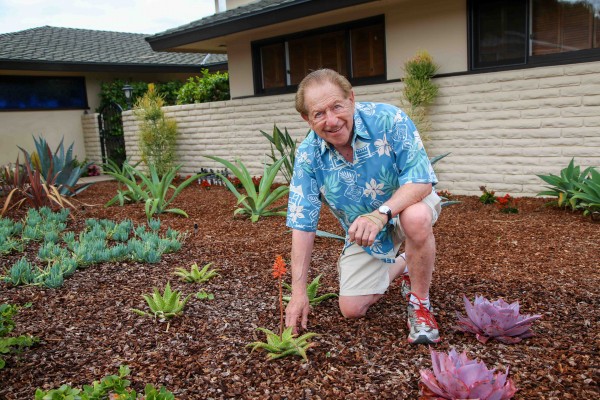Christopher Regan celebrated his 49th birthday by taking a long shower.
Regan, assistant general manager of the Laguna Beach County Water District, just got back Tuesday from the Northeast, where there’s no shortage of rain or snow pack.
“I felt guilty taking a five-minute shower,” Regan said. “It’s tough to leave my job. I was back there thinking, ‘They need a good turf-removal program. There’s a lot of turf. We’re talking acres.”

Heeding the cry to reduce water use in a parched state, Laguna Beach residents saved more water in May than they have in years, according to monthly reports released last week from the state Water Resources Control Board.
The lowered use came a month before Gov. Jerry Brown’s mandate to reduce water use by 24 percent went into effect in June. The average reduced water use for all of California, which is in the fourth year of a drought, was 28.9 percent, according to the water board. It is the biggest drop since the mandate was announced on April 1.
Laguna Beach water district customers reduced their use by 20 percent in May over the same month in 2013, the baseline year set by the state, said Regan. The district provides water to 25,000 people. At South Coast Water District, customers cut use by 29 percent over May, 2013, reported Andy Brunhart, general manager. SCWD serves South Laguna residents and an overall population of 35,000 in Dana Point, Capistrano Beach and areas of San Juan Capistrano and San Clemente.
In April, the Laguna Beach water district saw only a 3 percent drop since April 2013. “In April, none of this was going on,” said Regan. “There was no mandate by the governor.”
The top contributor to lowered water use, according to the state board, is less lawn irrigation. Reducing outdoor watering can account for 80 percent of residential water use, the state water board report stated.
The overall drop is also attributed to updated sprinkler systems, low-flow toilets and shower heads, water-efficient appliances, shorter showers and using sink and tub water for gardens and potted plants.
The governor’s mandate requires that California water suppliers cut use for a nine-month period, starting in June. “The reason the governor went to a mandatory 24 percent is because he asked for 20 percent voluntarily and he did not get it,” said Regan.
Declining use is drying up revenue for grants and rebates that encourage lower water use, Regan said. “I don’t think the rebates are going to last long,” said Regan. “Our revenue is dropping 24 percent. We have to sell 24 percent less water.”
That’s not the case with SCWD. Even with customers curbing consumption, Brunhart said $500 checks are going out monthly to customers for water-saving actions.
As of this month, 465 people have received rebates through the grant program, Brunhart said. Within the last 18 months, 235,000 square feet of lawn have been removed within the water district’s boundaries, he said. “Once you remove your lawn,” said Brunhart, “you’re saving far more water than what you do inside your house.”
Stanley Rosen lives in North Laguna and gets his water from LBCWD. He was early in the queue for a turf-removal grant from Metropolitan Water District. Rosen received $1,500 or $3 a square foot to replace his 500-square-foot lawn with succulents.
“What surprised me,” said Rosen, a retired physician, “was the beauty of succulents, the variegations of color, the variations of leaf. And now they’re beginning to show flowers that are exquisite. I didn’t even know succulents produced flowers.”
SCWD executives have met with their top 50 high-water users, Brunhart said, which includes hotels and resorts, golf courses, homeowner associations and government entities. “They’re throttling back on irrigation and they’re only irrigating one day a week,” he said.
As for residents who haven’t heeded restrictions, SCWD water bills now provide a graph comparing monthly use to 2013.
Leaks are also being monitored by the district with “leak letters.” Through automatic meter readings, the district can identify 24-7 water use. “That means they have a leak,” Brunhart said. In January 2014, SCWD sent out 1,000 letters. In June, 399 were sent.
“And we track every one of our customers if the leak still remains,” he said. “We offer to come to the resident’s home free of charge and help them find their leak.”
Laguna is in a dilemma as to what to do next about the drought, said Steve May, the city’s public works director. “We’ve already done a lot.”
At their next meeting on July 14, the City Council will consider removing some “low-use” grassy areas at city parks and turning off beachside showers. Even though turning off the showers would send a message that the city is serious about the drought, city staff is not recommending either option since both amount to minimal savings, May said.
For the long term, city staff is recommending drought-tolerant landscaping for any city renovation project. Because Southern California is semi-arid, he said, “We’re going to be up against this again sometime.”
The grass was already removed on the Laguna Canyon Road medians, the lawn at City Hall was replaced with drought-tolerant turf, city tennis courts are being swept and not washed, and city vehicles are being washed only when absolutely needed, May said.
This week, showers as well as some outside sinks at all state beaches and parks will be shut off for day-visitors and overnight campers and prices will increase at some pay showers, according to the state parks operations division.





[…] do here,” said Council member Kelly Boyd, who also praised residents for their conservation efforts. “We are hitting our goals, so the people in this town are really working hard,” he […]